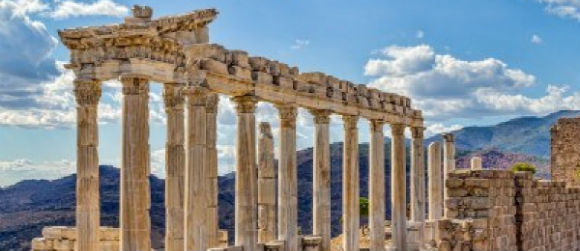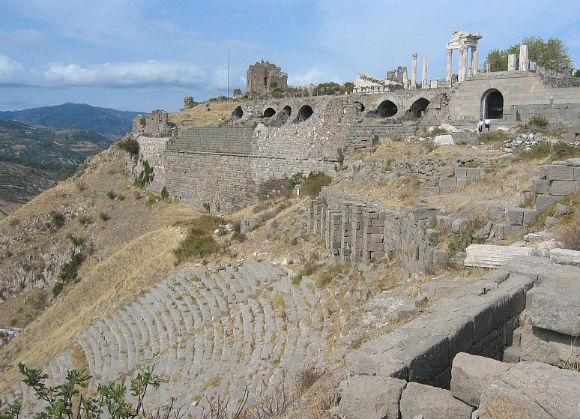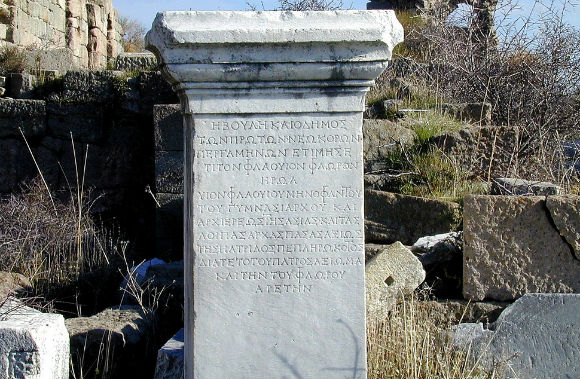The Acropolis of Pergamon was the site of the world’s second largest ancient library (after the library at Alexandria, Egypt). Eumenes II loved collecting books, and his library is said to have contained 200,000 books. At one point the rivalry between Alexandria and Pergamon became so intense that Egypt cut off its supply of papyrus to the city. Not to be deterred, Eumenes II challenged his scientists to find a replacement, and they did–pergamen, which is known as parchment in English. Parchment was derived from animal hides rather than pressed papyrus seeds and was more durable and could be written on both sides.
The Temple of Trajan is one of the best preserved structures still remaining on the Pergamon Acropolis. It was restored by the German Archaeological Institute. Scientists from the Institute excavated the entire site over many years, and many of the best artifacts are now contained in the Pergamon Museum of Berlin, Germany. I thought the most interesting structure on the Acropolis was the 10,000-seat theater, which is built into the hillside of the Acropolis and is one of the steepest in the world.
Those fascinated by Roman ruins could easily spend several hours at the Acropolis, especially if the weather is favorable. Our group had plenty of time to walk all over the site before riding the cable car back down to board our bus and drive to the Asclepion.
During the 350 years following the death of Alexander the Great (323 BC) until Pergamon (also spelled Pergamum) became a province of the Roman Empire (129 AD), it was one of the richest and important cities of the Middle East. The city reached its high point during the reign of King Eumenes II (197-159 BC).
Today, visitors can explore the historical remains and significant archaeological excavations at the Pergamon Acropolis, Red Basilica, and at the Asclepion (hospital complex), all of which is in the Turkish province of Izmir and only 16 miles from the Mediterranean Sea.
Located in downtown road to the Acropolis, the Red Basilica was built in the second century BC and was once a temple to the Egyptian God Serapis. In the Book of Revelations in the Christian Bible, St. John the Divine identified this basilica as the throne of the devil and one of the seven churches of the Apocalypse.
The Acropolis is accessed via a cable car, which was built just a few years ago. Previously, buses and cars drove a winding road to the summit, but now visitors park, pay a fee, and ride the cable car to the top. Once you exit the cable car, there’s a cafe and a few shops.
Walking around the ancient site of this important city’s acropolis is quite interesting, and the views of the surrounding countryside, the old Roman aqueducts, Pergamon and Asclepion are terrific.
This white stone at Pergamum with names inscribed reminds of Jesus’ words: “And to the angel of the church in Pergamos write…He that hath an ear, let him hear what the Spirit saith unto the churches; To him that overcometh will I give to eat of the hidden manna, and will give him a white stone, and in the stone a new name written, which no man knoweth saving he that receiveth it” (Rev 2:12, 17).
Acropolis of Pergamon,




I loved the Acropolis. It's a bit of a challenge physically (especially if stairs aren't your thing) but I have a very bad knee and am carrying extra kilos and I didn't let it stop me. Don't worry if your not fit, take your time – it's the only way to see it anyway! If you don't know much about…
There is a lot of walking, but well worth the visit to see these ancient ruins. We enjoyed taking the cable car (teleferik) up the hill, then slowly walking down to enjoy the rest of the ruins outside the "park."
To reach this site we drove to the base of the cable car and rode it to the Acropolis high on a hilltop overlooking Bergama. The ruins are extensive including a Heroon, upper market with Great Altar, Royal Palaces, etc. but the high points are (1) the extensive Trajaneum with library, halls, vaults beneath, and Sanctuary to Trajan and (2)…
Go and see it….The cable car ride is pretty cool too. It takes an hr to see
Well worth the trip to Bergama to see both the Acropolis Archrological site. You can drive all the way to the top or take a tram from the bottom. Amazing they were able to build all of this on top of a mountain in 500BC. MUCH less crowded than Ephesus and every bit as impressive. Not quite the same number…
A great place to just 'ramble'. Good variety of ruins and well signed.
As others have mentioned the Acropolis is truly amazing with the ruins of the library, the incredible theatre and the headless statue that you can stand on to see how you would look as a statue. The cable car ride up is spectacular and takes less than 5 minutes (though not great if you're scared of heights). My favourite part…
Lots of stairs and stones for climbing, but still manageable. Worth the walk up as you can have a bird's eye view of the entire town. A refreshing sight. Also grab some souvenir from the stalls along the entrance. Things are generally cheaper there.. Like you can get 6 evil eyes at 5 lira or 7 turkish purses at 5…
If you've been to the Pergamon museum in Berlin then you should have a clear picture of the original site but you've never guessed the very original site was like a ruined area!
A 5 minutes gondola ride will take you up to the mountain top. You've got beautiful views and stunning ruined site. There are lots of souvenir shops…
Situated on a hill, The Acropolis is a very impressive site. The teleferic that is in use for the last couple of years makes the visit easier and plus the view of Bergama town and the nearby dam lake is very beatiful during the commute. Usually tourists tend to visit only the part on the hill, whereas, I believe most…